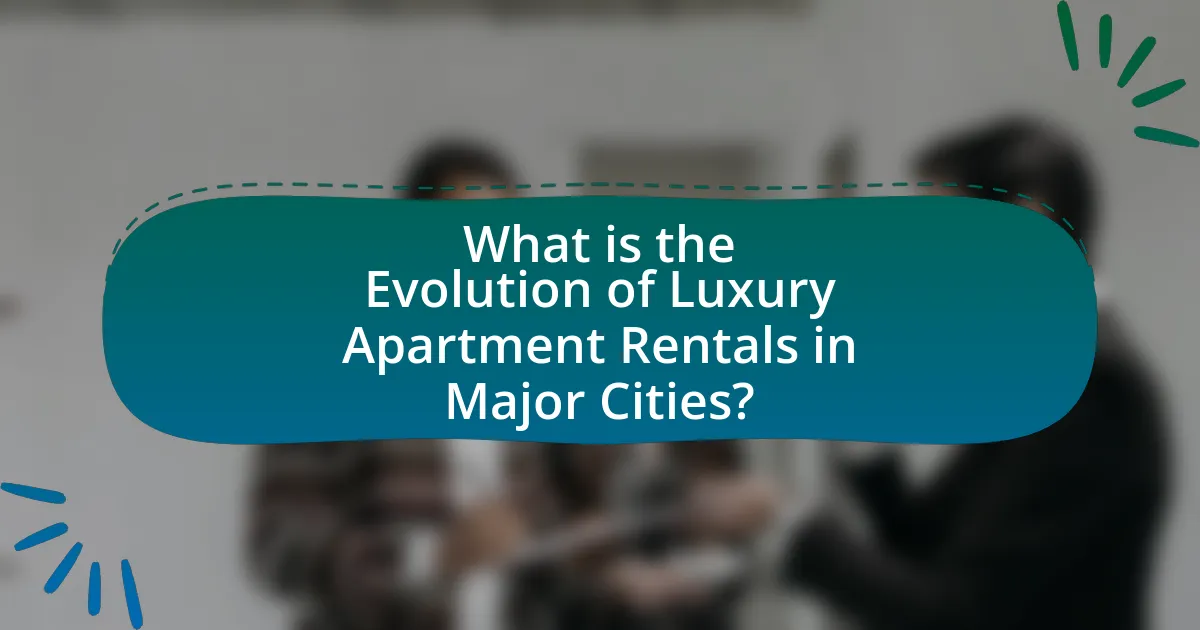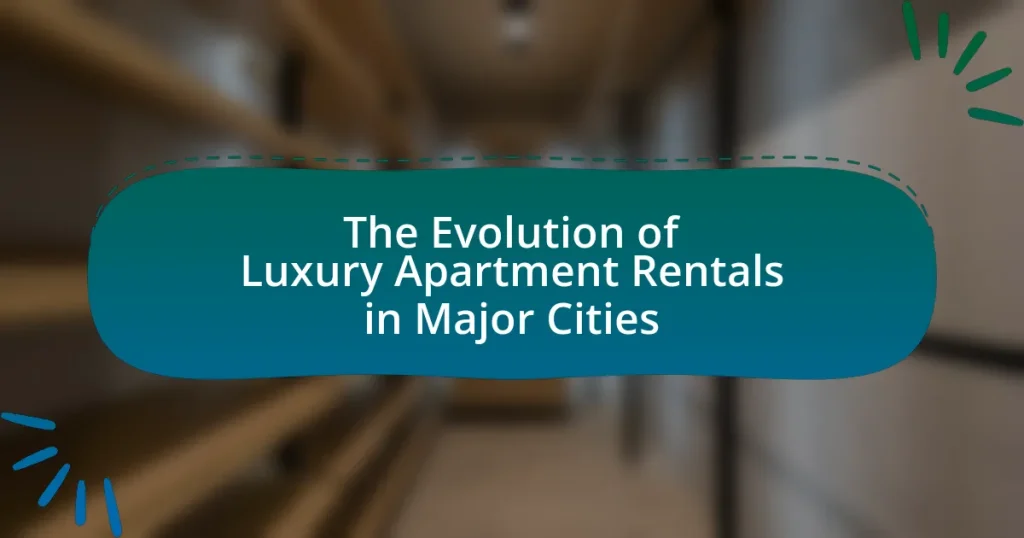The article examines the evolution of luxury apartment rentals in major cities, highlighting the transition from basic high-end living to a focus on lifestyle amenities and technology integration. It discusses how historical factors such as urbanization and economic growth have influenced the luxury rental market, as well as current trends emphasizing sustainability, smart home features, and wellness amenities. The piece also addresses the impact of demographic shifts, economic conditions, and regulatory challenges on the demand for luxury rentals, providing insights into what defines a luxury apartment today and best practices for potential renters.

What is the Evolution of Luxury Apartment Rentals in Major Cities?
The evolution of luxury apartment rentals in major cities has transitioned from basic high-end living to a focus on lifestyle amenities and technology integration. Initially, luxury apartments were characterized by spacious layouts and premium finishes, appealing primarily to affluent individuals seeking comfort and status. Over the past two decades, the demand has shifted towards properties that offer comprehensive amenities such as fitness centers, rooftop gardens, and concierge services, reflecting a lifestyle-oriented approach.
According to a report by CBRE, the luxury rental market in cities like New York and San Francisco has seen a significant increase in demand for smart home features and sustainable living options, indicating a trend towards modernity and environmental consciousness. Furthermore, the COVID-19 pandemic accelerated changes in preferences, with renters prioritizing flexible lease terms and remote work accommodations, leading to a rise in luxury rentals that cater to these needs. This evolution illustrates how luxury apartment rentals are increasingly shaped by societal trends and technological advancements.
How have luxury apartment rentals changed over the decades?
Luxury apartment rentals have evolved significantly over the decades, transitioning from basic amenities to high-end features and services. In the 1970s and 1980s, luxury apartments primarily offered spacious layouts and prime locations, with limited amenities. By the 1990s, the introduction of concierge services, fitness centers, and swimming pools became common, reflecting a shift towards lifestyle-oriented living.
In the 2000s, the rise of technology led to smart home features and high-speed internet becoming standard in luxury rentals. Recent trends show a focus on sustainability and wellness, with many luxury apartments now incorporating eco-friendly materials and wellness amenities like yoga studios and green spaces. According to a 2021 report by the Urban Land Institute, 70% of luxury renters prioritize sustainability in their housing choices, highlighting the ongoing transformation in the luxury rental market.
What historical factors influenced the rise of luxury apartment rentals?
The rise of luxury apartment rentals has been influenced by several historical factors, including urbanization, economic growth, and changing social dynamics. Urbanization in the late 19th and early 20th centuries led to increased demand for housing in cities, prompting developers to create upscale living spaces to attract affluent residents. Economic growth, particularly post-World War II, resulted in a burgeoning middle class with disposable income, further driving the demand for luxury accommodations. Additionally, changing social dynamics, such as the shift towards smaller households and the preference for convenience and amenities, have made luxury apartment rentals more appealing. These factors collectively contributed to the establishment and expansion of luxury apartment markets in major cities.
How have urbanization and population growth impacted luxury rentals?
Urbanization and population growth have significantly increased demand for luxury rentals in major cities. As urban areas expand and attract more residents, particularly young professionals and affluent individuals, the competition for high-end rental properties intensifies. According to a report by Knight Frank, luxury rental prices in urban centers have risen by an average of 5% annually over the past five years, driven by this heightened demand. Additionally, urbanization often leads to the development of upscale amenities and services, further enhancing the appeal of luxury rentals and justifying higher rental prices. This trend indicates a direct correlation between urban growth and the luxury rental market’s expansion.
What defines a luxury apartment rental today?
A luxury apartment rental today is defined by high-end amenities, prime locations, and superior design quality. These apartments typically feature modern appliances, spacious layouts, and exclusive services such as concierge and fitness centers. According to a 2022 report by the Urban Land Institute, luxury rentals in major cities have increasingly incorporated smart home technology and sustainable building practices, reflecting a growing demand for convenience and environmental consciousness among affluent renters.
What amenities and features are commonly found in luxury apartments?
Luxury apartments typically feature high-end amenities such as gourmet kitchens, spa-like bathrooms, and expansive living spaces. These apartments often include additional features like smart home technology, concierge services, fitness centers, rooftop terraces, and swimming pools. The presence of these amenities enhances the living experience, catering to the desires for comfort, convenience, and luxury. For instance, a study by the National Multifamily Housing Council indicates that 70% of luxury apartment renters prioritize amenities like fitness centers and pools, underscoring their importance in attracting residents.
How do location and design contribute to the luxury status of an apartment?
Location and design significantly enhance the luxury status of an apartment by influencing desirability and perceived value. Prime locations, such as urban centers or exclusive neighborhoods, attract affluent residents due to proximity to amenities, cultural institutions, and social hubs, which are essential for a luxurious lifestyle. For instance, apartments in areas like Manhattan or Beverly Hills command higher prices due to their prestigious addresses and access to high-end shopping, dining, and entertainment.
Design elements, including high-quality materials, innovative architecture, and bespoke interiors, further elevate an apartment’s luxury status. Luxury apartments often feature open floor plans, large windows for natural light, and state-of-the-art appliances, which appeal to discerning buyers. According to a report by the National Association of Realtors, properties with modern design and premium finishes can sell for up to 20% more than comparable units with standard features, underscoring the impact of design on perceived luxury.
Why is the demand for luxury apartment rentals increasing?
The demand for luxury apartment rentals is increasing due to a combination of urbanization, rising disposable incomes, and a shift in lifestyle preferences. Urbanization has led to more individuals moving to major cities, where luxury apartments are often located in desirable areas with access to amenities. Additionally, as disposable incomes rise, more people can afford higher rental prices, making luxury apartments more accessible. Lifestyle preferences have also shifted towards valuing experiences and convenience, prompting individuals to seek out luxury rentals that offer modern amenities and services. According to a report by Knight Frank, the global luxury rental market has seen a significant uptick, with demand increasing by 10% in major cities over the past year, highlighting the growing trend in this sector.
What demographic trends are driving the luxury rental market?
The luxury rental market is primarily driven by the increasing number of affluent millennials and Gen Z individuals seeking urban living experiences. This demographic shift is characterized by a preference for flexibility, convenience, and high-quality amenities, which luxury rentals provide. According to a report by Knight Frank, the number of high-net-worth individuals is projected to grow significantly, with millennials expected to inherit substantial wealth, further fueling demand for luxury rental properties. Additionally, urbanization trends show that younger generations are gravitating towards metropolitan areas, where luxury rentals are often located, enhancing their appeal.
How do lifestyle changes influence the appeal of luxury apartments?
Lifestyle changes significantly enhance the appeal of luxury apartments by aligning them with modern consumer preferences for convenience, sustainability, and community. As urban residents increasingly prioritize work-life balance, luxury apartments that offer amenities such as co-working spaces, fitness centers, and communal areas become more attractive. Additionally, the growing emphasis on sustainability drives demand for eco-friendly features like energy-efficient appliances and green building certifications, which are often found in luxury developments. According to a 2021 report by the National Multifamily Housing Council, 70% of renters consider sustainability an important factor in their housing choices, underscoring the influence of lifestyle changes on the desirability of luxury apartments.
How do economic factors affect the luxury apartment rental market?
Economic factors significantly influence the luxury apartment rental market by determining demand, pricing, and investment trends. For instance, during economic growth, higher disposable incomes lead to increased demand for luxury rentals, driving up rental prices. Conversely, during economic downturns, reduced consumer spending can decrease demand, resulting in lower rental prices and higher vacancy rates. Additionally, interest rates impact investment in luxury properties; lower rates encourage developers to build more luxury apartments, while higher rates can stifle new developments. According to a report by the Urban Land Institute, luxury apartment rents in major cities rose by an average of 4% annually during periods of economic expansion, illustrating the direct correlation between economic conditions and rental market dynamics.
What role does technology play in the evolution of luxury apartment rentals?
Technology significantly enhances the evolution of luxury apartment rentals by streamlining processes and improving tenant experiences. Innovations such as virtual tours, online leasing platforms, and smart home technologies allow potential renters to explore properties remotely, simplifying the decision-making process. For instance, a report by the National Multifamily Housing Council indicates that 70% of renters prefer to view apartments online before visiting in person, showcasing the demand for digital solutions. Additionally, smart home features, like automated lighting and security systems, not only attract tech-savvy tenants but also increase property value, as properties equipped with such technologies can command higher rental prices. Thus, technology plays a crucial role in shaping the luxury rental market by enhancing accessibility, efficiency, and desirability.
What are the current trends in luxury apartment rentals?
Current trends in luxury apartment rentals include a significant demand for amenities that enhance lifestyle, such as smart home technology, fitness centers, and co-working spaces. The rise of remote work has led to an increased preference for larger living spaces that accommodate home offices. Additionally, sustainability features, like energy-efficient appliances and green building certifications, are becoming essential for many renters. According to a 2023 report by the National Multifamily Housing Council, 70% of luxury renters prioritize eco-friendly options in their housing choices. This shift reflects a broader societal trend towards sustainability and convenience in urban living.
How are sustainability and eco-friendliness shaping luxury rentals?
Sustainability and eco-friendliness are increasingly shaping luxury rentals by driving demand for energy-efficient features and environmentally responsible practices. Luxury rental properties now often incorporate renewable energy sources, such as solar panels, and utilize sustainable materials in construction and furnishings. For instance, a report by the Global ESG Benchmark for Real Assets indicates that properties with green certifications can command rental premiums of up to 20%. Additionally, tenants are prioritizing eco-friendly amenities, such as water-saving fixtures and smart home technologies that reduce energy consumption, reflecting a broader societal shift towards environmental consciousness. This trend not only enhances the appeal of luxury rentals but also aligns with the values of a growing demographic that prioritizes sustainability in their lifestyle choices.
What innovations are being introduced in luxury apartment design?
Innovations in luxury apartment design include smart home technology, sustainable materials, and wellness-focused amenities. Smart home technology allows residents to control lighting, temperature, and security systems remotely, enhancing convenience and energy efficiency. The use of sustainable materials, such as recycled or locally sourced products, reflects a growing emphasis on environmental responsibility in design. Additionally, wellness-focused amenities like fitness centers, meditation spaces, and air purification systems cater to residents’ health and well-being, aligning with current lifestyle trends. These innovations are reshaping luxury apartment living, making it more functional, eco-friendly, and health-conscious.
What challenges do luxury apartment rentals face in major cities?
Luxury apartment rentals in major cities face several challenges, including high competition, fluctuating demand, and regulatory hurdles. High competition arises from an increasing number of luxury developments, which saturates the market and can lead to price wars. Fluctuating demand is influenced by economic conditions, such as job growth and income levels, which can vary significantly across different urban areas. Regulatory hurdles include zoning laws and rent control measures that can restrict rental prices and limit the ability to make necessary renovations. These factors collectively impact the profitability and sustainability of luxury apartment rentals in urban environments.
How do economic downturns impact luxury rental prices?
Economic downturns typically lead to a decrease in luxury rental prices. During such periods, demand for high-end rentals declines as individuals and businesses face financial constraints, resulting in increased vacancy rates. For instance, during the 2008 financial crisis, luxury rental prices in major cities like New York and San Francisco dropped by approximately 10-20% as tenants sought more affordable housing options. This trend indicates that economic instability directly influences the luxury rental market by forcing landlords to adjust prices to attract tenants.
What regulatory issues affect the luxury rental market?
Regulatory issues affecting the luxury rental market include zoning laws, short-term rental regulations, and tenant protection laws. Zoning laws dictate where luxury rentals can be located, often limiting availability in desirable areas. Short-term rental regulations, such as those imposed by cities like New York and San Francisco, restrict the ability to rent properties for less than 30 days, impacting income potential for luxury property owners. Tenant protection laws, which vary by jurisdiction, can impose rent control measures and eviction protections, influencing the profitability and management of luxury rentals. These regulations collectively shape the operational landscape for luxury rental properties, affecting both supply and demand dynamics in major urban markets.
What are the best practices for renting a luxury apartment?
The best practices for renting a luxury apartment include conducting thorough research on the property and its amenities, understanding the lease terms, and assessing the neighborhood. Researching the property involves checking online reviews, visiting the apartment in person, and verifying the reputation of the landlord or management company. Understanding lease terms is crucial, as luxury apartments often have specific clauses regarding maintenance, security deposits, and termination. Assessing the neighborhood ensures that it meets lifestyle preferences, such as proximity to work, entertainment, and public transportation. These practices are essential for making informed decisions and ensuring a satisfactory rental experience.
How can renters negotiate better terms for luxury apartments?
Renters can negotiate better terms for luxury apartments by conducting thorough market research and leveraging comparable rental prices in the area. By analyzing listings and recent rental transactions, renters can present data to landlords that demonstrate competitive pricing, which can justify requests for lower rent or additional amenities. For instance, if similar luxury apartments in the neighborhood offer lower rates or better features, this information can strengthen a renter’s position during negotiations. Additionally, timing negotiations during off-peak rental seasons, such as winter months, can increase the likelihood of favorable terms, as landlords may be more willing to negotiate to fill vacancies.
What should potential renters consider before signing a lease for a luxury apartment?
Potential renters should consider the total cost of living in a luxury apartment, which includes rent, utilities, maintenance fees, and any additional amenities. The average rent for luxury apartments in major cities can exceed $3,000 per month, and hidden costs can significantly impact overall affordability. Renters should also evaluate the lease terms, including duration, renewal options, and penalties for breaking the lease, as these factors can affect long-term financial commitments. Additionally, the location’s proximity to essential services, public transportation, and entertainment options is crucial, as it influences daily convenience and lifestyle. Lastly, renters should assess the reputation of the property management and the quality of maintenance services, as these aspects directly affect living conditions and tenant satisfaction.


